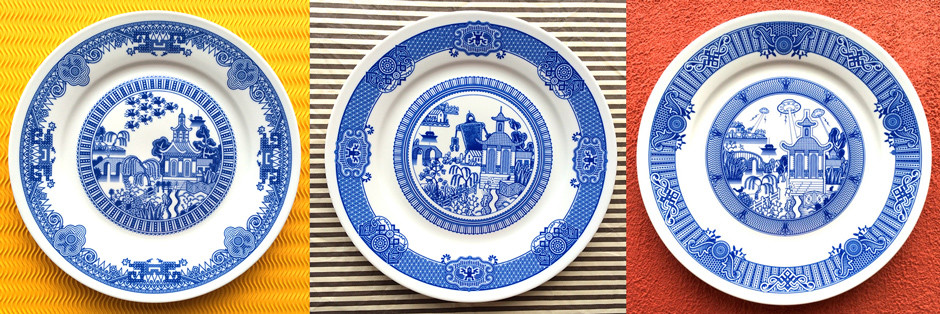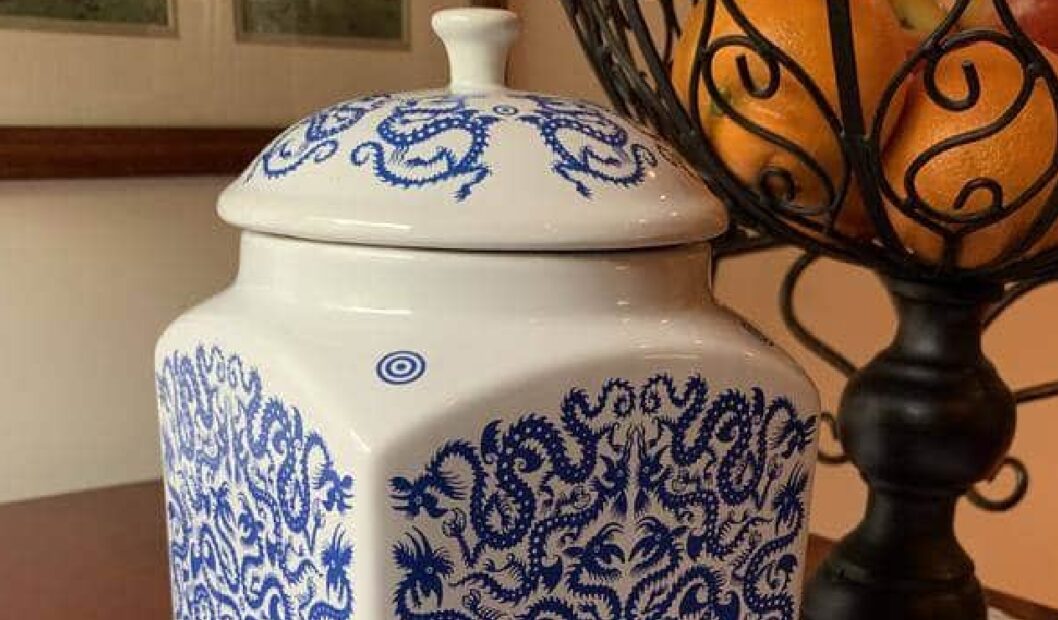Intro: Don Moyer has completed six successful Kickstarter projects and gradually found ways to share his unusual products with people who appreciate things that are beautiful, useful, and funny. The first product was a porcelain plate that added the calamity of flying monkeys to a traditional blue, Willow-pattern dinner plate. Additional projects added more plates, mugs, bandanas, and more. All celebrate traditional designs, but add a twist.
Can you start by giving us a quick overview?
I retired last year. For 40 years, I worked as a designer solving problems for my clients. Now I get to define my own projects and explore things that I think are fun. I draw every day and some of my drawings become products that people will enjoy having in their homes. I use Kickstarter to find sponsors for these self-inflicted projects. I also have a Shopify site link where folks who missed the Kickstarter projects can catch up.
I don’t manufacture anything myself. I want to design things and rely on others to help with business tasks—production, customer service, accounting, etc. Fulfillrite is my partner to handle packing, shipping, and tracking of orders.
Where did the idea for Calamityware come from?
I love to draw. The drawings I like best make me laugh.
When I inherited a traditional Willow-pattern dinner plate, I felt an urge to redraw the scene and add a pterodactyl. Countless porcelain manufacturers have made versions of these traditional plates for nearly 300 years. All feature variations of a vaguely Asian scene with willow trees, pagodas, bridges, exotic plants, and more. I enjoyed drawing several versions of plates and added a different calamity each time. Think Sasquatch, volcanoes, and voracious sea monsters.
I post my daily drawings on Flickr. Several people who saw my plate drawings urged me to reproduce the drawings on real plates. When I retired, I had time to experiment with Kickstarter to fund production of a real porcelain plate.

Why did you use crowdfunding?
Crowdfunding is perfect for projects like this. An artist has an idea for a project that is too ambitious to finance alone. If enough people are willing to support it, the funds for the project are available. If there are not enough supporters, you get to walk away from the idea having spent very little time and money.
The old method was to borrow money and fund a production run. Before crowdfunding platforms like Kickstarter and Indiegogo, too many people ended up with debt and a basement full of products they could never sell. Those days are gone.
My first project (flying monkeys) was fun and reached its funding goal, so I promised myself that if interest remained high, I’d do a series of at least 8 plates…maybe 12.
How do you create new products?
First, I goof around. I draw things and explore possibilities. No rush. No pressure. Basically, I’m trying to please myself. So I draw things that I like. When I find something that is both beautiful and funny, I’m satisfied.
Sometimes my supporters suggest product ideas. These unsolicited ideas are almost always wrong for me. But on rare occasions, they may offer an idea that fits my sense of humor.
I can’t stress enough the importance of simply messing around, doodling, and exploring for pure fun. For me, that’s where the best ideas come from.
Who is your audience?
One of the surprising things about Kickstarter has been how easy it is to get feedback from sponsors about why they are supporting my project. Kickstarter makes it easy to have digital conversations with sponsors. So, I’ve formed impressions of my sponsors.
In general, my sponsors are diverse in terms of gender and age. They live all over the world but most are in the US. They all have a good sense of humor and appreciate the notion that products can be beautiful, utilitarian, and funny at the same time.
I think that the people who sponsor Kickstarter projects are looking for something new. They are looking for things that are not yet in stores or weird products that are never going to be found in any store. Some of them are drawn to the idea of supporting an artist who’s trying to pursue a goofy quest.
What problems have you encountered?
Problems are part of bringing any new product to market. One expects that. In fact, watching how problems are dealt with is part of the fun of supporting Kickstarter projects. Updates about problematic suppliers, pokey supply chains, and problems with packaging are common.
Initially, I didn’t invest in any business systems. My first projects were pretty small, so it was possible to get by with rudimentary tools like a spreadsheet and a note pad.
My biggest problem was a lack of transparency. I couldn’t get fast, accurate, honest answers from key suppliers about what was really happening. This problem was compounded when supporters and customers asked questions about the status of the project. If I answered based on the latest information from the production team, I found myself, a few days later, issuing a correction and an apology. At times I had to craft apologies for my apologies.
Apologizing was NOT how I wished to spend my days. I wanted to be drawing or designing the next product. Within a few months, I became a foot shorter and displayed a permanent frown.
All this changed when I finally got my inventory installed at Fulfillrite. Suddenly, I had full visibility through their web portal, of inventory levels, order status, tracking numbers, and postage funds. My smile returned.
With Fulfillrite, I export the address file from Kickstarter, clean it up slightly, and upload it to Fulfillrite’s web portal. It immediately becomes visible on my Fulfillrite web portal. As the orders are packed and shipped, I can see the status on my screen. Most recipients get an email with a tracking number when their shipment rolls out the door.
Orders that come to my Shopify site flow on to Fulfullrite electronically and also become visible immediately. Everything seems to go out the same day the order is received.
Fulfillrite also gives me constant visibility of inventory levels so I can make decisions about production. All in all, a simple and beautiful system. I wish I had found Fulfillrite sooner.
How did you go beyond porcelain plates?
Working with Fulfillrite has also made it possible to add more products. In late November 2014, I launched a Kickstarter project for BADbandana 1—the world’s first bandanas with angry paisleys. This blue bandana celebrates traditional bandanas but adds the excitement of monsters, pests, a plethora of bats, and other bad boys.
By consolidating all fulfillment with Fulfillrite, I can accommodate mixed orders—plates, bandanas, whatever. So now there’s nothing to prevent adding all kinds of new products. Move over Amazon.
What’s next?
I have a list of more than 100 potential projects. It’s my bucket list. I’d like to see how many of these projects I can complete before I kick the bucket.
For 2015, there will be a new series of four Calamityware plates (Pirates in the neighborhood, Rambunctious volcano, Tentacles!, and Vortex of doom). My sixth Kickstarter project is BADbandana 2—Pixels on a rampage is a mash-up of early video game characters and genteel embroidery with more than 260 monsters and minions.
I’m working on a letterpress print with sea monsters, robots on tea pots, ugly mugs, bowls, and some holiday cards. I also have requests for designs for pocket squares, tea pots, gravy boats, playing cards, socks, and neck ties. I’ve added them to the bucket list.
Any more advice before you go?
If you need an unusual gift for someone, I urge you to visit Calamityware.com.
Crowdfunding is perfect for projects like this. An artist has an idea for a project that is too ambitious to finance alone. If enough people are willing to support it, the funds for the project are available. If there are not enough supporters, you get to walk away from the idea having spent very little time and money.

